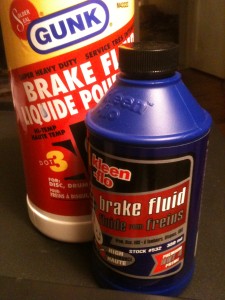If the brake lines in your GM Brakes are arteries, brake fluid would be the life blood that does the work. Brake fluid must be able to flow freely at extremely high temperatures (260 degrees C, 500 degrees F) and at very low temperatures (-75C, -104F). Brake fluid must also lubricate the parts it comes in contact with as well as fight corrosion and rust in the brake lines and various brake assemblies and components. With all the rusted GM brake lines in the news right now, I’m wondering if it’s because certain models may have the non-teflon coated brake lines from the factory or if the brake fluid was not flushed and changed according to GM maintenance schedules. In my opinion it may be a combination of both as most vehicle owners never think twice about flushing the brake fluid in their cars.
Brake fluid has to resist evaporation, however it’s also hygroscopic; that is, it readily absorbs water. This is why you should never open up the brake fluid reservoir cap if you can see the fluid level through a transparent reservoir. Never used brake fluid from an old container as you don’t know how much water it may have absorbed. Because of this “hygroscopic” quality of brake fluid, after a year of service, the brake fluid has about 2% water. After 18 months, the level can be as high as three percent. If you don’t change your brake fluid after several years, you could have as much as seven to ten percent of water in the brake lines. Thus causing your brake lines to rust! All the water seeps in through pores in the rubber hoses, seals, and through the fluid reservoir every time it’s opened for inspection (so don’t open the cap if you can see the fluid level from the sides.) So if you have GM brake lines that are rusty, ask yourself, when did you last bleed ALL the brake fluid from the vehicle (usually by pressure bleeding or “power bleeding”?
Three types of Brake Fluid:
DOT 3: Conventional brake fluid with a minimum dry equilibrium reflux boiling point (ERBP) of 205 degrees C (401 degrees F) and minimum wet ERBP (3% moisture contamination) of 140 degress C (284 degrees F.)
DOT 4: Is a conventional brake fluid with a higher boiling point. An ERBP of 230 degrees C (446 degrees F) and a meinimum wet ERBP of 180 degrees C (356 degrees F.)
DOT 5: Is a unique silicone-based brake fluid witha minimum dry ERBP of 260 degrees C (500 degrees F) and a minimum wet ERBP of 180 degrees C (356 degrees F). DO NOT MIX DOT 5 brake fluid with DOT 3 or DOT 4 glycol based brake fluids. Even if you drain and refill your brake system with DOT 5 fluid, any residual glycol fluid will form slugs that may concentrate moisture. If the fluid gets hot enough, the slugs may boil and cause loss of pedal. Also, do not use DOT 5 in ABS brake systems as it absorbs air and foam when cycled rapidly through the ABS orifices.
DOT 5.1: is a non-silicone-based polyglycol fluid and is amber in color. It has the same boiling point as DOT 5 fluid.
Always use the type of brake fluid that’s specified by the vehicle manufacturer!
Some general guidelines:
-Avoid contact with brake fluid, it can cause irritation and is harmful/fatal if swallowed.
-Do not splash or spill DOT 3/4 brake fluid on painted surfaces (it will take the paint off!) If you do spill, don’t wipe. Flush immediately with water!
-Only use fresh brake fluid from a NEW sealed container. Do not reuse old fluid or brake fluid from an open or unmarked container.
-Don’t open the master cylinder fluid reservoir if you don’t have to.
To keep your gm brakes working optimally, you need to flush the brake fluid in your gm brakes according to GM’s maintenance schedule.

